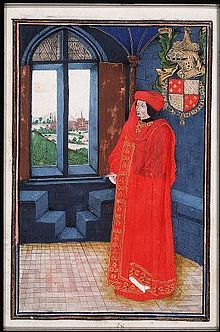Iñigo de Guevara
Iñigo de Guevara (* around 1418 in Castile; † 1462 ), Marchese del Vasto , Conte di Ariano , di Apice e di Potenza was a Basque nobleman who lived in southern Italy in the service of King Alfonso V of Aragón from his youth . He is also called Juan de Guevara in the sources and literature .
Life
He was born around 1418 as the eldest son of Pedro Velez de Guevara, Señor de Oñate , and Constanza de Tovar in Castile . After the death of his father, his mother married Ruy López Dávalos, the Connetable of Castile, who was defeated against King Alfonso V of Aragon , went into exile with the family and died in Valencia in 1428 .
Iñigo de Guevara probably took part in Alfonso's second campaign in Sicily (1432) and then also (from 1435) in the battles for the Kingdom of Naples . Due to his military achievements, he was enfeoffed with the possessions of Francesco Sforzas and Micheletto Attendolo , which, however, were still to be conquered.
In the naval battle of Ponza (August 5, 1435), like the king, he was taken prisoner, which he spent with Filippo Maria Visconti in Milan . After her release, he was back in the field in February 1436. In 1438 he won the Battle of San Germano and signed an armistice with Francesco Sforza. He was appointed royal majordomo and in 1440 received the cities of Ariano and Apice - these too had to be taken away from Sforza, which he succeeded in May 1441. He also played an important role in the conquest of Naples (June 2, 1442) and the decisive battle of Carpenone (June 28, 1442). In July he negotiated again with Sforza, with the aim of bringing him into the service of the king, and arranged the marriage between Francesco's son and Alfons' daughter - which Alfons in turn viewed as exceeding his powers and then rejected. However, this seems to have had no negative effects, as Guevara shortly afterwards received the title of Count of Ariano and in November 1442 that of Count of Potenza. In 1444 he was appointed Marchese del Vasto.
In 1445 he fought again against Sforza. From 1446 he took part in Alfonso's Tuscany campaign, from which he was sent to Rome in March 1447 as the king's representative for the coronation of Pope Nicholas V. On September 10, 1448 he was in the unsuccessful attempt to conquer Piombino . On December 26th, he was entrusted with the office of Grand Seneschal, one of the Kingdom's seven major offices.
In 1451 Iñigo de Guevara was accepted into the Order of the Golden Fleece . The background to the recording was the intention of Duke Philip the Good of Burgundy to organize a crusade; in order to gain the support of Alfonso V for this company, he had accepted him into the order in 1445 and now six years later two of his most important advisors (the other was Pedro de Cardona , Count of Collesano). The handover of the chain of the order was carried out by Jean le Fèvre, Seigneur de Saint-Rémy as king of the coat of arms and the knights of the order Jacques de Lalaing and Jean II. De Croÿ , who traveled to Sicily for this purpose.
Two years later, Alfons and Guevara's relationship began to cool. In a campaign that he led from October 1453 on behalf of the sick king, Guevara had disregarded his orders and left the troops at the end of the year to return to Naples. Alfonso appears to have tolerated his behavior, however, Guevara does not appear to have received any other awards in the last four years of the king's reign.
The change of government in 1458 gave him his property, but reduced the number of his offices; his loyalty to King Ferdinand I continued when the Neapolitan nobility rebelled in 1459. He also stood by his side in the defeat of Sarno in July 1460, and on August 18, 1462 in the decisive battle of Troy. After this battle he was assigned to pursue the rebels in Abruzzo , where he was killed.
family
Iñigo de Guevara was married to Lucrezia Sanseverino for the first time . His second wife was Covella Sanseverino, sister of the Duke of San Marco . His children from the second marriage are:
- Pedro / Pietro de Guevara, Marchese del Vasto, Conte d'Ariano e Apici, Grand Clerk of the Kingdom of Naples-Sicily, ∞ Andria 1471 Isotta Ginevra des Baux (del Balzo), 2. Principessa di Altamura († 1530), daughter of Pierre / Pietro des Baux, 4th Duca d'Andria, 1st Principe di Altamura, Grand Konnetabel of the Kingdom of Naples-Sicily, and Marie Donata Orsini Balzo
- Francisca de Guevara; ∞ Francisco della Ratta, Conte di Caserta
- Antonio de Guevara, Conte di Potenza , Viceroy of Naples
literature
- Alan Ryder: Guevera, Iñigo. In: Dizionario Biografico degli Italiani . Volume 60 (2003), [1]
- Detlev Schwennicke : European family tables . Volume III.4 (1989) Plate 750 (Les Baux de Berre)
- Raphael de Smedt (ed.): Les chevaliers de l'ordre de la Toison d'or au XVe siècle. Notices bio-bibliographiques. (Kieler Werkstücke, D 3) 2nd, improved edition, Verlag Peter Lang, Frankfurt 2000 ( ISBN 3-631-36017-7 ), No. 48.
Web links
Remarks
- ↑ Sonja Dünnebeil (ed.), The Protocol Books of the Order of the Golden Fleece, Volume 1, Duke Philipp the Good (2002), Appendix, No. 118, p. 182
| personal data | |
|---|---|
| SURNAME | Iñigo de Guevara |
| ALTERNATIVE NAMES | Juan de Guevara |
| BRIEF DESCRIPTION | Knight of the Order of the Golden Fleece |
| DATE OF BIRTH | around 1418 |
| PLACE OF BIRTH | Castile |
| DATE OF DEATH | 1462 |

